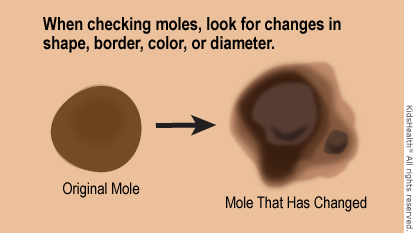Melanoma
Article Translations: (Spanish)
What Is Melanoma?
Melanoma (pronounced: mel-eh-NOE-muh) is a type of cancer that begins in a melanocyte (pronounced: meh-LAN-uh-site), a cell in the top layer of skin (the epidermis). Melanocytes make melanin (pronounced MEL-eh-nun), the pigment that gives skin its color.
Melanoma also can develop in other parts of the body, like the eyes, mouth, genitals, and anal area.
What are the Signs & Symptoms of Melanoma?
Often, melanoma begins as a mole or a bump on the skin. It's important to know if a mole has changed in size, shape, or color.
Keep this ABCDE rule in mind when checking moles:
- A for asymmetry: If you were to cut the mole down the middle, would the left and the right sides look different?
- B for border: Are the edges blurry and undefined? Does it look like it's spreading sideways?
- C for color: Does the mole look darker or lighter than usual, or does it have an area of new color — perhaps black, blue, purple, red, or white?
- D for diameter: Is the mole larger than the eraser on a pencil top?
- E for evolving: Has there been any change in the size, shape, color, or elevation of the mole?

Melanoma most commonly develops on the trunk, head, and neck for guys, and the lower legs for girls.
What Causes Melanoma?
One of the most important contributors to melanoma is ultraviolet (UV) sun damage. Cells that have been damaged — particularly by short bouts of bad, blistering sunburns during childhood or regular tanning bed use as a teen or young adult — are more likely to become cancerous over time.
Sometimes melanoma begins in an area where there is no dark spot or bump.
Melanoma happens when melanocytes stop working normally. Because of a genetic change (mutation), they begin growing out of control, sticking together to form tumors, crowding out healthy cells, and damaging surrounding tissue.
Who Gets Melanoma?
Risk factors that can increase a person's chances of melanoma include:
- a fair complexion (light skin that freckles or burns easily)
- blue or green eyes
- blond or red hair
- having many moles (usually, more than 25)
- UV exposure (from the sun or a tanning bed)
- having a history of frequent or severe sunburns
- having a relative with melanoma or a family history of oddly shaped moles
- age (older people are at greater risk)
- having had melanoma before
Though less likely, people can still get melanoma even if they're young, have no family history of cancer, or have dark skin.
How Is Melanoma Diagnosed?
The doctor will do a biopsy, removing all or part of the lesion (the affected area of skin) and look at its cells under a microscope. A biopsy shows if the cells are cancerous. It can also show how deep they are in the skin, which can help doctors predict the risk of the melanoma spreading.
How Is Melanoma Treated?
Melanoma treatment can include:
- surgery to remove the cancerous lesion
- chemotherapy: tumor-killing medicines are given by mouth, through an injection (a shot), or intravenously (into a vein)
- targeted therapy: specific medicines that find and attack cancer cells without hurting normal cells
- immunotherapy (biologic therapy): when doctors stimulate the body's own immune system to fight cancer cells
The treatment chosen depends on:
- how big and how deep the lesion is
- what part of the body it is on
- whether the cancer has spread
Can Melanoma Be Cured?
Melanoma that's caught early, when it's still on the surface of the skin, can be cured.
Untreated melanoma can grow downward into the skin until it reaches the blood vessels and lymphatic system. This lets it travel to distant organs, like the lungs or the brain. That's why early detection is so important.
Can Melanoma Be Prevented?
You can't control how fair your skin is or whether you have a relative with cancerous moles. But there are things you can do to lower your risk of developing melanoma. The most important is limiting your exposure to the sun.
Take these precautions:
- Avoid the strongest sun of the day — between 10 a.m. and 4 p.m.
- Use broad-spectrum sunscreen (SPF 30 or more) whenever you're in the sun.
- Wear a wide-brimmed hat and cover up with long, loose cotton clothing if you burn easily.
- Stay out of the tanning salon. Even one indoor tanning session increases your risk of getting melanoma.
Also, be sure to check your moles often (you may need to ask a friend to help with those hard-to-reach areas, like your back and scalp). Keep dated records of each mole's location, size, shape, and color, and get anything suspicious checked out right away.
Not all skin cancer is melanoma, but every case of melanoma is serious. So now that you know more about it, take responsibility for protecting yourself and do what you can to lower your risk.
You can find more information online at:
Note: All information is for educational purposes only. For specific medical advice, diagnoses, and treatment, consult your doctor.
© 1995-2024 KidsHealth ® All rights reserved. Images provided by iStock, Getty Images, Corbis, Veer, Science Photo Library, Science Source Images, Shutterstock, and Clipart.com

